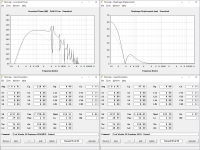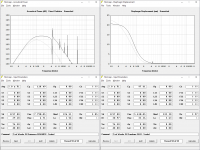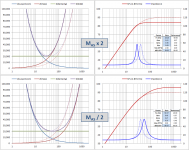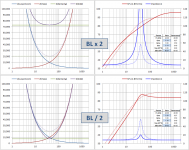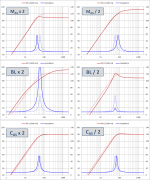So Patrick if am looking for build the efficiency sub-woofer what exactly T/S parameter(s) should I look for in a driver?
The actual Hornresp power and efficiency charts for the given Post #17 inputs are:
I did post five....your original version. I hadn't seen post 17 when I posted. Also note that in the FB group those guys are using these drivers into the range where the Eminence has been the far and away driver efficiency winner in every post I've seen....
Last edited:
"Partick": You are making some serious hand waving and "look over here!" kind of arguments. For this specific example of these two drivers in this horn you are correct, but in general not.
What you are observing is how the near and below resonance behavior of two drivers with different Thiele-Small parameter values can line up and be relatively the same. This is nothing new or different. A driver's efficiency and sensitivity values are quoted typically at "mid band" meaning for the middle of a flat passband in e.g. a vented or closed box. We all (including you) know that for e.g. 1W input the SPL is not constant but varies with frequency. You are comparing a driver with higher midband efficiency and lower Qts with a driver having lower midband efficiency and higher Qts, at low frequencies. What you are observing is really not all that surprising for your single example, but I would not over generalize this to "all" subwoofers and say that efficiency is "irrelevant".
Sorry, but there is absolutely nothing new here, folks.
If I could I would give the title of this thread a "pants on fire" rating!
What you are observing is how the near and below resonance behavior of two drivers with different Thiele-Small parameter values can line up and be relatively the same. This is nothing new or different. A driver's efficiency and sensitivity values are quoted typically at "mid band" meaning for the middle of a flat passband in e.g. a vented or closed box. We all (including you) know that for e.g. 1W input the SPL is not constant but varies with frequency. You are comparing a driver with higher midband efficiency and lower Qts with a driver having lower midband efficiency and higher Qts, at low frequencies. What you are observing is really not all that surprising for your single example, but I would not over generalize this to "all" subwoofers and say that efficiency is "irrelevant".
Sorry, but there is absolutely nothing new here, folks.
If I could I would give the title of this thread a "pants on fire" rating!
Fun informative thread thread folks 🙂
In line with just a guy's comments that mid-band sensitivity has nothing to do with efficiency at subwoofer frequencies,
and also the one that says you cannot make comparisons until frequency response is the same,
I'd like to offer my method of determining sensitivity, and making comparisons.
I hope this isn't focusing on too narrow of a topic subset, ie sensitivity alone.
But given the knowledgeable particpants in this thread, I'm hoping to hear if anybody sees problems with my method.
In a nutshell, my method is to measure with processing in place.
So first step is to put all processing in place which includes high-pass and low-pass filters, along with any leveling EQ's.
This processing is meant to be the actual processing for intended usage.
Then I use full range pink noise as the driver signal, and simultaneously measure the average RMS voltage at the driver, and average flat SPL, over a time period long enough to get settled repeatable results.
Usually takes 30 seconds to 1 min. Takes a good voltmeter, but otherwise very easy to.
Then, it's just a matter and doing the math, and pulling it down to 2.83V at 1m, or 2V etc.
So I think i end up with an average voltage sensitivity, under intended usage.
Sometimes out of curiosity, I'll derive a measured average impedance as well, taking an average current reading over the same time period, along with the voltage and SPL averages.
I do it for subs, mids, highs....anytime I'm comparing two designs meant to cover the same frequency range.
For those comparisons, I just make sure I get the same acoustic frequency response output between the boxes.
IOW, boxes are processed to have matching response. It's not very hard, and it's the response I want in the end anyway.
I realize all this does is give what I'd call a real world nominal sensitivity and a real world nominal impedance, but they seem to be hell of better specs that i ever see in print.
I also realize i can't extrapolate this sensitivity number up to AES power ratings to gauge max SPL, without looking at excursion and various power limitations etc, in Hornresp.
But does anyone see any flaws in the basic methodology?
thx, mark
In line with just a guy's comments that mid-band sensitivity has nothing to do with efficiency at subwoofer frequencies,
and also the one that says you cannot make comparisons until frequency response is the same,
I'd like to offer my method of determining sensitivity, and making comparisons.
I hope this isn't focusing on too narrow of a topic subset, ie sensitivity alone.
But given the knowledgeable particpants in this thread, I'm hoping to hear if anybody sees problems with my method.
In a nutshell, my method is to measure with processing in place.
So first step is to put all processing in place which includes high-pass and low-pass filters, along with any leveling EQ's.
This processing is meant to be the actual processing for intended usage.
Then I use full range pink noise as the driver signal, and simultaneously measure the average RMS voltage at the driver, and average flat SPL, over a time period long enough to get settled repeatable results.
Usually takes 30 seconds to 1 min. Takes a good voltmeter, but otherwise very easy to.
Then, it's just a matter and doing the math, and pulling it down to 2.83V at 1m, or 2V etc.
So I think i end up with an average voltage sensitivity, under intended usage.
Sometimes out of curiosity, I'll derive a measured average impedance as well, taking an average current reading over the same time period, along with the voltage and SPL averages.
I do it for subs, mids, highs....anytime I'm comparing two designs meant to cover the same frequency range.
For those comparisons, I just make sure I get the same acoustic frequency response output between the boxes.
IOW, boxes are processed to have matching response. It's not very hard, and it's the response I want in the end anyway.
I realize all this does is give what I'd call a real world nominal sensitivity and a real world nominal impedance, but they seem to be hell of better specs that i ever see in print.
I also realize i can't extrapolate this sensitivity number up to AES power ratings to gauge max SPL, without looking at excursion and various power limitations etc, in Hornresp.
But does anyone see any flaws in the basic methodology?
thx, mark
"Partick": You are making some serious hand waving and "look over here!" kind of arguments. For this specific example of these two drivers in this horn you are correct, but in general not.
What you are observing is how the near and below resonance behavior of two drivers with different Thiele-Small parameter values can line up and be relatively the same. This is nothing new or different. A driver's efficiency and sensitivity values are quoted typically at "mid band" meaning for the middle of a flat passband in e.g. a vented or closed box. We all (including you) know that for e.g. 1W input the SPL is not constant but varies with frequency. You are comparing a driver with higher midband efficiency and lower Qts with a driver having lower midband efficiency and higher Qts, at low frequencies. What you are observing is really not all that surprising for your single example, but I would not over generalize this to "all" subwoofers and say that efficiency is "irrelevant".
Sorry, but there is absolutely nothing new here, folks.
If I could I would give the title of this thread a "pants on fire" rating!
I agree 100%
I mostly hang out in car audio, home audio and home theater forums. Facebook and Youtube have done a great job of attracting a lot of casual users to this hobby.
Most casual users have never touched Hornresp in their life, and never will.
In YouTube and Facebook forums, there's a dizzying amount of misinformation.
One piece of misinformation that's been getting repeated over and over and over and over is that "you should use a high efficiency driver."
When this advice is tossed out, offhand, it's rarely followed up with an explanation of WHY one might use a high efficiency driver, or what the advantages are.
This leads to a scenario where a lot of audio consumers are writing off hundreds of drivers based on single spec: sensitivity.
It's a confusing and misleading spec, in fact I mixed it up myself in the title of this thread, and I've been designing loudspeakers for almost 30 years! So if I'M getting confused by the subject, it's no surprise that the casual car audio enthusiast won't dive deep on the topic.
The fundamental challenge here, is that sensitivity is a spec that's measured in the midband.
I honestly believe that if you surveyed a hundred casual home audio and car audio enthusiast about their understanding of sensitivity, more than 50% would assume that a speaker with a sensitivity of 90dB will produce more output at 40hz than a speaker with a sensitivity of 80dB.

For instance, the Eminence NSW4018 has a spec sheet that says "97dB" and the Sundown SA18 has a spec sheet that says "91dB" but at 40Hz, in an identical box, their output is basically identical.
So Patrick if am looking for build the efficiency sub-woofer what exactly T/S parameter(s) should I look for in a driver?
My argument is basically that I wouldn't lose a lot of sleep worrying about sensitivity.
For instance, you and I live in San Diego. One square foot of real estate is about $600.
Because of that, optimizing for efficiency is kinda silly IMHO. IE, if you're watching movies with your system, you'll want output down to 20Hz, and an efficient subwoofer that plays down to 20Hz is going to be the size of a refrigerator.
If you could reduce your subwoofer box by 75% by spending an additional $200 on your amplifier, does that justify saving $2000 in real estate?
And this doesn't even factor in WAF.
Back in the day I didn't think this way at all, I built a LOT of horn subs. Front loaded horns and a lot of tapped horns.
About four years ago I built a plain ol' bandpass with dual fifteens. It's outlasted all of the horn subs I've built.
For me, I think that part of the reason that it's outlasted just about every component in my stereo is because it just gets the job done. It's not "punchy" or "loud" or "impressive."
It's neutral. It digs deep and the distortion is so low, at least once a month I have to check to verify that it's on. Because it's so transparent it often seems like it's not even doing anything, until I turn it off and immediately notice it's absence.
The actual Hornresp power and efficiency charts for the given Post #17 inputs are:
Whoops...Sorry David...for some reason I thought Patrick had posted that, and I was referring to him when I used You're/your....
My bad....
Scott
I did post five....
Ah, that explains why there are subtle differences in our results. Thanks.
Whoops...Sorry David...
Hi Scott,
Not a problem, I knew what you meant to say 🙂.
Kind regards,
David
Hi All,
Bennet Prescott made an article about subwoofer efficiency. I think it
explaines it all.
Higher BL motor is always a higher efficiency system (more newton per ampere flow) the motor structure is able to produce. Read this with the condition that the resistance is at a fixed rate.
Very many times swapped wrong with sensitivity.
https://bennettprescott.com/downloads/TechTalk_Design_202002.pdf
Best Regards,
Marcel
Bennet Prescott made an article about subwoofer efficiency. I think it
explaines it all.
Higher BL motor is always a higher efficiency system (more newton per ampere flow) the motor structure is able to produce. Read this with the condition that the resistance is at a fixed rate.
Very many times swapped wrong with sensitivity.
https://bennettprescott.com/downloads/TechTalk_Design_202002.pdf
Best Regards,
Marcel
There is one other item of interest that the OP (Patrick) or other readers might want to consider, keep in mind, etc and that is true efficienicy vs midband efficiency. The true efficiency is more like the efficiency vs frequency (if I am recalling the terminology correctly) and is something that has come into the fore in recently times as very high BL, low Qts pro drivers become more commonly available.
When a driver has very low Qts the impedance peak around its resonance is quite broad. This means that the impedance magnitude (the AC impedance) does not fall back to Re for several octaves below resonance. Therefore the impedance at low (e.g. subwoofer) frequencies often remains several times higher than "nominal".
The higher impedance causes the driver to draw less current and it will do that in a relatively wide band BELOW the impedance peak. Because modern class-D amplifiers are available with very high voltage output you can bring much more voltage to bear when powering the driver, but without requiring so much current. This kind of operation should be less stressful for the output devices and will drain the power supply caps more slowly than when high current is required.
When you look at a box modeler for a low Qts (e.g. Qts=0.2 or less) driver, the situation looks hopeless and it often seems that a higher Qts driver would be better. But because the low Qts driver will not draw as much current as the high Qts driver, it is actually more efficient in a true Watts sense than the high Qts driver.
There was a thread about this topic in this forum (or at least on DIYaudio) about 6-12 months ago. Initially I argued that the high Qts driver would be better until I sat down and did some sims myself. I was surprised that when I calculated the true Watts (Volts*Amps, but not including phase angle) that the low Qts driver required LESS power to achieve the same SPL. That did come at the cost of having to apply a higher drive voltage, but that is indeed possible these days.
I immediately ran out and bought a Behringer NX6000 when I saw the results of my True Power modeling. This inexpensive amp can put out peak Watts of several kW into 4R but only for a brief period of time. The problem is that the PS is not large, so if you also need to pump lots of current you will not get good results at low frequencies because the peak of the signal waveform lasts longer than the PS has current reserve. But if we instead use a low Qts pro audio driver the current draw will be much reduced and the PS rails will be able to hold up even at low frequency. My plan is to use a large, low Qts driver in a large closed box and, with DSP, EQ the frequency response to flatten and extend the bass. The large box also helps to keep the true efficiency high, and keep distortion low while the CB should keep the time domain response crisp and clean. If you have the room for it, this seems like a winning combination to me.
So, for the low Qts versus high Qts case you can see that "subwoofer efficiency" can actually be quite relevant when viewed as SPL per "true" Watt of input power. This idea was touched on but not explicitly stated in the link that Marcello provided in his post, immediately prior to this one. I thought I would spell it out in a little more detail.
When a driver has very low Qts the impedance peak around its resonance is quite broad. This means that the impedance magnitude (the AC impedance) does not fall back to Re for several octaves below resonance. Therefore the impedance at low (e.g. subwoofer) frequencies often remains several times higher than "nominal".
The higher impedance causes the driver to draw less current and it will do that in a relatively wide band BELOW the impedance peak. Because modern class-D amplifiers are available with very high voltage output you can bring much more voltage to bear when powering the driver, but without requiring so much current. This kind of operation should be less stressful for the output devices and will drain the power supply caps more slowly than when high current is required.
When you look at a box modeler for a low Qts (e.g. Qts=0.2 or less) driver, the situation looks hopeless and it often seems that a higher Qts driver would be better. But because the low Qts driver will not draw as much current as the high Qts driver, it is actually more efficient in a true Watts sense than the high Qts driver.
There was a thread about this topic in this forum (or at least on DIYaudio) about 6-12 months ago. Initially I argued that the high Qts driver would be better until I sat down and did some sims myself. I was surprised that when I calculated the true Watts (Volts*Amps, but not including phase angle) that the low Qts driver required LESS power to achieve the same SPL. That did come at the cost of having to apply a higher drive voltage, but that is indeed possible these days.
I immediately ran out and bought a Behringer NX6000 when I saw the results of my True Power modeling. This inexpensive amp can put out peak Watts of several kW into 4R but only for a brief period of time. The problem is that the PS is not large, so if you also need to pump lots of current you will not get good results at low frequencies because the peak of the signal waveform lasts longer than the PS has current reserve. But if we instead use a low Qts pro audio driver the current draw will be much reduced and the PS rails will be able to hold up even at low frequency. My plan is to use a large, low Qts driver in a large closed box and, with DSP, EQ the frequency response to flatten and extend the bass. The large box also helps to keep the true efficiency high, and keep distortion low while the CB should keep the time domain response crisp and clean. If you have the room for it, this seems like a winning combination to me.
So, for the low Qts versus high Qts case you can see that "subwoofer efficiency" can actually be quite relevant when viewed as SPL per "true" Watt of input power. This idea was touched on but not explicitly stated in the link that Marcello provided in his post, immediately prior to this one. I thought I would spell it out in a little more detail.
Last edited:
... I was surprised that when I calculated the true Watts (Volts*Amps, but not including phase angle) that the low Qts driver required LESS power to achieve the same SPL. That did come at the cost of having to apply a higher drive voltage, but that is indeed possible these days…. So, for the low Qts versus high Qts case you can see that "subwoofer efficiency" can actually be quite relevant when viewed as SPL per "true" Watt of input power.
A nice easy to follow explanation
 , and thanks for sharing your road to discovery.
, and thanks for sharing your road to discovery.This was exactly what Bob Carver was getting at 25 years ago in his original Sunfire sub white paper. His use of analogy with electric motors, stall mode, and back EMF left people used to dealing in TS parameters shaking their heads. But, once you got past the eye-rolling hyperboles characteristic of Bob’s literature…many subwoofer designers slowly started to realize he was actually on to something.
The best analysis I’ve seen on the topic is the attached 2003 AES paper available on Keele’s website.
AES Papers -- Official website of D.B.Keele
"…To conclude, if your design can accommodate equalization before the power amplifier and the power amplifier can provide higher voltage swing, then raise your driver’s Bl product to the highest possible value consistent with material and economic constraints! This will result in the highest efficiency design."
I had previously posted the referenced Vanderkooy paper on the same topic here: How does Hornresp use BL?
Attachments

What I don't get, is why there is a difference in dBs? If excursion and SD are the same, shouldn't the amount of dB produced be as well? What am I overlooking?😱
Those car subs are quite human, response ends 60hz so people doesn´t suffer hearing loss so easy.
Unfortunately the excursion plot doesn't correspond with the dB plot. The excursion plot appears to be from the comparison shown in Post#13. The other issue of course is that in a vented enclosure the total acoustic output doesn't correspond to excursion around the tuning frequency.If excursion and SD are the same, shouldn't the amount of dB produced be as well?
Attached are vented and sealed enclosure comparisons using the Hornresp inputs from Post#34. You can see the excursion and dB correspond in a logical fashion except for in the region of the vented enclosure tuning.
Attachments
Ah, that explains it. I thought the simulation was done with identical enclosures, seeing that the enclosure parameters were the same in the image.
Thanks for taking the effort to clear things up!😉😎
Thanks for taking the effort to clear things up!😉😎
The enclosures are identical, but the heavier driver is less sensitive, so has less upper excursion and output given the same power level.I thought the simulation was done with identical enclosures, seeing that the enclosure parameters were the same in the image.
After receiving a few PM questions, I thought it might be helpful to post some of the trend plots I had generated a while back to illustrate how changing the 3 major electro-mechanical parameters of a woofer(mass, suspension compliance, and BL) affect TS parameters, mid-band sensitivity, and response for the same applied amplifier voltage. I grouped a few of the plots in what is hopefully a logical presentation.
Attachment #1: The analogical model of a loudspeaker in an infinite baffle can be simplified down to a series resonant circuit driven by a voltage representing Pressure (ie Force per unit piston area). The current thru the circuit represents volume velocity(ie piston velocity x piston area). The resulting acoustic output is proportional to volume velocity, and can be calculated based on formulas and methods documented in many acoustic texts and AES articles. You can see that the impedance of the series circuit can be divided into 3 regions. For frequencies above resonance, the total impedance(and thus the piston velocity and acoustic output) is almost completely defined by the inductor MAS representing the total moving mass. Below resonance the impedance is almost completely defined by the capacitor CAS representing suspension compliance. For a couple octaves around resonance the resistor RAT representing the total damping in the system is dominate in defining the total impedance. This is where the terms stiffness, damping, or mass controlled comes from. When you change the value of one these 3 major parameters, you will see a change in the corresponding control range. The SPL and impedance for an 8ohm 10” woofer in an infinite baffle were used as a reference.
Attachment #2: With drive voltage unchanged, this is the effect of doubling or halving the moving mass. Note that mid-band sensitivity is changed +/- 6dB as expected, but in the subwoofer range there is very little difference. This is likely a major factor at play in the confusion between car/pro woofer sensitivity ratings and acoustic output at subwoofer frequencies when driven by the same amplifier.
Attachment #3: With drive voltage unchanged, this is the effect of doubling or halving BL or magnet strength. Doubling BL increases mid-band and very low band sensitivity by +6dB, but the electrical part of the damping(RAT) is increased by 4x and overdamps the response around resonance. Happily, as CharlieLaub mentioned, the impedance peak around resonance is increased in magnitude and broadened. So, if you have an amplifier capable of swinging high voltages, you can EQ that range and reclaim the “lost” dBs without burning up the voice coil.
Attachment #4: With drive voltage unchanged, this is the effect of doubling or halving the suspension compliance. Note that response changes are limited to the frequency range below resonance, and is changed +/- 6dB.
Attachment #5: Put the woofer in a 1.5 ft^3 enclosure and the trends are essentially the same for mass and BL, but the effect of compliance changes is less pronounced. This makes sense when you realize that the compliance of the enclosure is modeled by adding an additional capacitor in series with the capacitor representing the suspension compliance. As just a guy mentioned, the enclosure size can have a dominate influence on bass output, especially when it is sized to have compliance < Vas.
The matter of voice coil inductance was excluded from the calculations for clarity. In reality all woofers have some amount of inductance. The higher the inductance the more the response will droop below the ideal non-inductive SPL curves shown in the trend plots.
Attachment #1: The analogical model of a loudspeaker in an infinite baffle can be simplified down to a series resonant circuit driven by a voltage representing Pressure (ie Force per unit piston area). The current thru the circuit represents volume velocity(ie piston velocity x piston area). The resulting acoustic output is proportional to volume velocity, and can be calculated based on formulas and methods documented in many acoustic texts and AES articles. You can see that the impedance of the series circuit can be divided into 3 regions. For frequencies above resonance, the total impedance(and thus the piston velocity and acoustic output) is almost completely defined by the inductor MAS representing the total moving mass. Below resonance the impedance is almost completely defined by the capacitor CAS representing suspension compliance. For a couple octaves around resonance the resistor RAT representing the total damping in the system is dominate in defining the total impedance. This is where the terms stiffness, damping, or mass controlled comes from. When you change the value of one these 3 major parameters, you will see a change in the corresponding control range. The SPL and impedance for an 8ohm 10” woofer in an infinite baffle were used as a reference.
Attachment #2: With drive voltage unchanged, this is the effect of doubling or halving the moving mass. Note that mid-band sensitivity is changed +/- 6dB as expected, but in the subwoofer range there is very little difference. This is likely a major factor at play in the confusion between car/pro woofer sensitivity ratings and acoustic output at subwoofer frequencies when driven by the same amplifier.
Attachment #3: With drive voltage unchanged, this is the effect of doubling or halving BL or magnet strength. Doubling BL increases mid-band and very low band sensitivity by +6dB, but the electrical part of the damping(RAT) is increased by 4x and overdamps the response around resonance. Happily, as CharlieLaub mentioned, the impedance peak around resonance is increased in magnitude and broadened. So, if you have an amplifier capable of swinging high voltages, you can EQ that range and reclaim the “lost” dBs without burning up the voice coil.
Attachment #4: With drive voltage unchanged, this is the effect of doubling or halving the suspension compliance. Note that response changes are limited to the frequency range below resonance, and is changed +/- 6dB.
Attachment #5: Put the woofer in a 1.5 ft^3 enclosure and the trends are essentially the same for mass and BL, but the effect of compliance changes is less pronounced. This makes sense when you realize that the compliance of the enclosure is modeled by adding an additional capacitor in series with the capacitor representing the suspension compliance. As just a guy mentioned, the enclosure size can have a dominate influence on bass output, especially when it is sized to have compliance < Vas.
The matter of voice coil inductance was excluded from the calculations for clarity. In reality all woofers have some amount of inductance. The higher the inductance the more the response will droop below the ideal non-inductive SPL curves shown in the trend plots.
Attachments
- Home
- Loudspeakers
- Subwoofers
- Subwoofer Efficiency is Mostly Irrelevant
